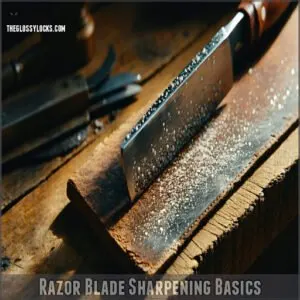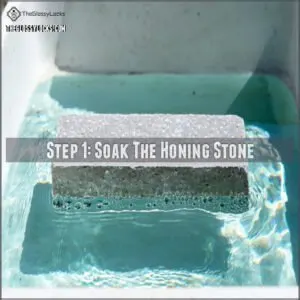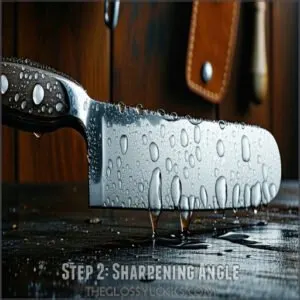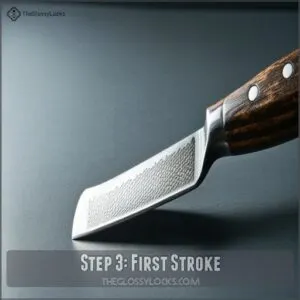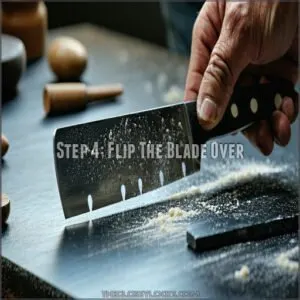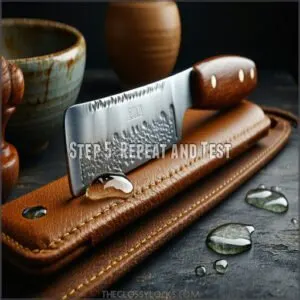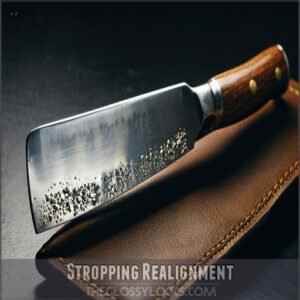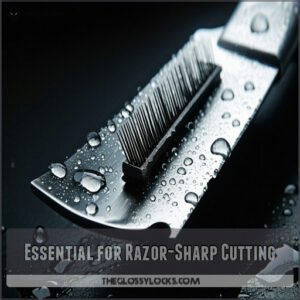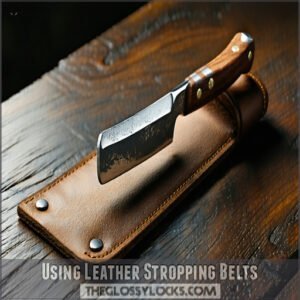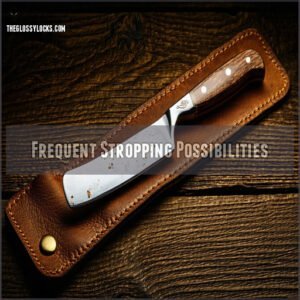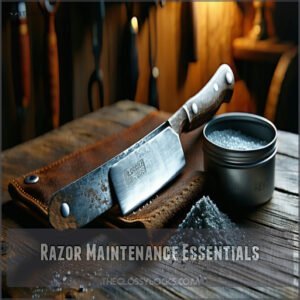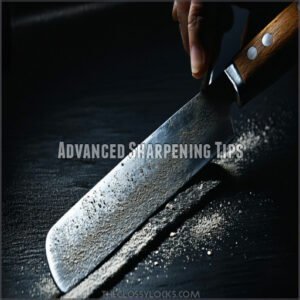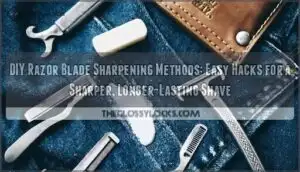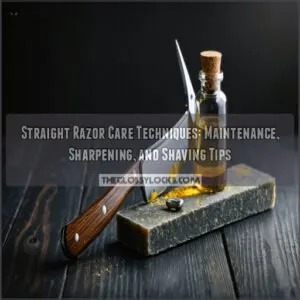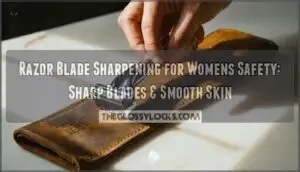This site is supported by our readers. We may earn a commission, at no cost to you, if you purchase through links.
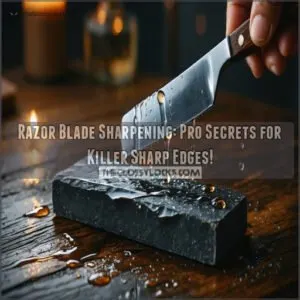
Maintain a gentle 15-degree angle and let your fingers do the work when stropping. Push the blade up the stone smoothly, realigning its edge and removing microscopic burrs.
This technique additionally extends blade life by 7-8 additional shaves while reducing skin irritation and improving shaving precision.
By sharpening regularly, you’ll save money, reduce plastic waste, and transform a mundane grooming task into a precision art. Ready to elevate your shaving game?
Table Of Contents
- Key Takeaways
- Razor Blade Sharpening Basics
- Honing Techniques Explained
- Stropping Methods Detailed
- Razor Maintenance Essentials
- Advanced Sharpening Tips
- Frequently Asked Questions (FAQs)
- How do I make my razor blade sharper?
- How to get a straight razor super sharp?
- Does baby oil keep razor blades sharp?
- How do I keep my razor blades sharp?
- How often should I sharpen my razor?
- Can electric razors be manually sharpened?
- What damages razor blades the most quickly?
- Do expensive razors require different sharpening?
- Are there risks of over-sharpening blades?
- Conclusion
Key Takeaways
- Save money and reduce waste by learning to sharpen your razor blades, extending their life by 7-8 extra shaves with proper maintenance techniques.
- Master the critical sharpening angle (15-20 degrees for most razors) and use a well-prepared honing stone to restore your blade’s precision cutting edge.
- Clean and dry your razor thoroughly after each use, then protect it with a light coat of mineral oil to prevent rust and maintain its sharp performance.
- Stropping is your secret weapon – use a leather strop with gentle, consistent strokes to realign the blade’s edge and remove microscopic burrs, keeping your razor razor-sharp between deep sharpenings.
Razor Blade Sharpening Basics
If you’re tired of spending money on new razor blades or want to reduce waste, learning to sharpen your razors is a game-changer.
You’ll enjoy saving cash and helping the environment while also enjoying a closer, smoother shave that’ll make your morning routine feel like a professional grooming experience.
Importance of Sharp Blades
Surprisingly, blade efficiency isn’t just about cutting—it’s about control and safety.
A sharp razor transforms your shaving experience, reducing nicks and ensuring smoother strokes.
Mastering razor blade sharpening means understanding how a keen edge protects your skin, extends blade longevity, and delivers precision cuts every single time.
Your razor becomes more than a tool—it’s a precision instrument.
Effective razor blade sharpening techniques can greatly improve the overall shaving experience.
Benefits of Razor Sharpening
Sharp razor blades can transform your shaving experience from a chore to a precision art. Razor sharpening offers multiple game-changing benefits:
- Enhanced razor efficiency
- Superior cutting precision
- Improved blade longevity
- Reduced skin irritation
- Consistent, smooth shaving performance
By mastering razor sharpening techniques, you’ll elevate your grooming routine, ensuring each stroke delivers professional-level results with minimal effort and maximum comfort.
Cost-Effectiveness and Environmental Friendliness
Want to save cash and help the planet? Eco-friendly game changer razor blade sharpening is here. By extending each blade’s life, you’ll slash plastic waste and trim your budget.
One sharpened blade can deliver 7-8 extra close shaves, potentially tripling your razor’s lifespan.
You can learn effective stropping techniques to maintain sharpness.
It’s a win-win for your wallet and the environment—smart, sustainable grooming at its finest.
Honing Techniques Explained
You’ll learn the art of honing razor blades like a pro with these essential techniques that transform dull edges into precision cutting tools.
Master the right angle, pressure, and motion, and you’ll extend your blade’s life while achieving that perfectly sharp edge every time.
Step 1: Soak The Honing Stone
Ready to elevate your razor blade sharpening game? Proper stone preparation sets the stage for a killer edge. Before you begin honing, you’ll want to prep your sharpening stone like a pro. You can find honing stone soak products online. Here’s what you need to know:
- Soak the stone for 5-10 minutes
- Use clean, room temperature water
- Make sure complete stone surface is wet
- Remove any air bubbles during soaking
A well-prepped stone makes all the difference in blade care.
Step 2: Sharpening Angle
Because precision matters in razor sharpening, mastering the right angle is your secret weapon. Your blade’s sharpness hinges on consistent angle control during honing. Proper razor maintenance extends the life of your blades.
| Angle Range | Blade Type |
|---|---|
| 10-15° | Japanese Razors |
| 15-20° | Western Razors |
| 20-25° | Utility Blades |
| 25-30° | Heavy-Duty Cutting |
| 30-35° | Robust Edges |
Nail the bevel setting, and you’ll slice through hair like a pro.
Step 3: First Stroke
Now that you’ve positioned your blade at the right angle, it’s time to make your first stroke count. Glide the razor smoothly across the honing stone, maintaining consistent pressure and keeping your blade aligned.
You can find honing steel products online.
Think of it like painting a delicate line—steady, controlled, and precise. Your goal? Create a razor-sharp edge that’ll slice through hair like a hot knife through butter.
Step 4: Flip The Blade Over
After sliding the blade across one side of the stone, your next move is critical: blade edge reversal. Carefully flip the razor, maintaining its original angle and balance. Your goal? Symmetric sharpening for a perfectly honed edge.
You can purchase blade edge reversal products online.
Key flip techniques:
- Keep wrist steady
- Maintain consistent angle
- Use gentle, controlled motion
- Mirror initial side’s technique
Precision matters in razor sharpening techniques.
Step 5: Repeat and Test
After carefully flipping the blade, you’ll want to repeat the honing process on the other side with the same precise angle.
Proper straight razor care techniques are essential for maintaining a sharp blade.
Now comes the moment of truth: test your razor’s sharpness. Make gentle test cuts to verify the edge alignment. Check for smoothness and consistency. A truly sharp blade glides effortlessly, revealing your mastery of razor sharpening techniques.
Stropping Methods Detailed
You’ll find that stropping your razor blade keeps it sharp by realigning the edge and removing tiny burrs that affect its cutting ability.
With the right technique and a leather strop, you can extend your blade’s life and get a closer shave every time.
Stropping Realignment
Your razor’s edge needs realignment after every few shaves.
Stropping helps bring that keen edge back to life by straightening microscopic bends in the blade geometry.
You’ll want to use proper stropping technique with correct sharpening angles – about 15 degrees works best.
Run your blade along the strop in smooth, consistent motions to restore cutting efficiency.
It’s like giving your razor a spa day!
Smoothing Impurities and Burrs
The fine art of smoothing impurities and burrs transforms your blade from rough to refined. Through careful stropping technique, you’ll remove microscopic metal burrs that affect your shave.
Here’s what happens during edge refining:
- Metal polishing realigns jagged microfibers
- Blade smoothing removes damaged edge particles
- Burr removal creates a clean cutting surface
- Edge becomes microscopically straight
- Cutting optimization reaches maximum efficiency
You’ll feel the difference immediately as your razor glides effortlessly across your skin.
Essential for Razor-Sharp Cutting
To achieve that razor-sharp edge, you’ll need to master proper stropping techniques. Your blade’s cutting performance depends on regular maintenance and attention to detail.
By removing microscopic burrs and realigning the edge, you’re ensuring clean, precise cuts every time. Test your blade’s sharpness by gently running it across a hanging hair—if it splits effortlessly, you’ve nailed your technique.
Using Leather Stropping Belts
The art of leather strop care transforms your razor sharpening game.
Your leather strop becomes a precision tool for edge realignment when you hang it taut and smooth.
Apply light, consistent pressure as you drag the blade away from you.
Maintain a steady angle and watch your razor’s edge become razor-sharp with each masterful stropping technique.
Frequent Stropping Possibilities
After mastering leather stropping belts, you’ll want to know how often to strop your blade.
Seasoned shavers recommend stropping before each use, keeping your edge razor-sharp.
Quick, light strokes on leather or denim can realign your blade’s edge in seconds.
Don’t overdo it—15-20 gentle passes maintain that killer sharp finish without wearing down your straight razor prematurely.
Razor Maintenance Essentials
You’ve invested in a quality razor, so it’s time to learn how to keep it in excellent condition with expert maintenance techniques.
Discover the secrets to cleaning, disinfecting, and protecting your razor blade.
Ensuring a smooth, precise shave every single time.
Cleaning The Blade
Sink water becomes your razor’s best friend during blade cleaning.
Rinse your razor thoroughly after each use, washing away hair, shaving cream, and skin residue with warm water.
Gently scrub with a soft toothbrush to remove stubborn debris.
Water rinsing preserves your razor blade’s edge and prevents buildup that can compromise steel honing and overall razor blade longevity.
Disinfecting The Blade
Your razor’s health hinges on high-quality disinfection. Use an alcohol-based cleaner to zap bacteria and prevent skin infections.
Gently swipe the blade with an astringent solution, targeting every nook and cranny.
For alternative methods, explore various disinfection techniques.
A microfiber cloth guarantees thorough sterilization without scratching.
Quick, careful blade sanitizing keeps your razor clean, safe, and ready for a perfect shave.
Drying The Blade Thoroughly
After disinfecting your blade, drying becomes your next mission.
Grab a clean, lint-free cloth and pat the razor dry with gentle, thorough strokes.
Moisture is a razor’s nemesis, so leave no water droplets behind.
Prevent water spots and potential rust by ensuring every nook and cranny is completely dry.
Your blade’s longevity depends on this quick, simple step.
Applying Mineral or Cooking Oil
After thoroughly drying your blade, protect it with a thin layer of mineral or cooking oil. This lubrication method creates a barrier against moisture, preventing rust and maintaining your sharp edge.
Use a soft cloth to apply a light, even coat.
Your razor blade sharpening technique just got an upgrade – oil is your new best friend for long-lasting blade performance.
Storing Razors in Dry Locations
Anyone serious about razor blade maintenance knows that proper storage is essential for preserving that killer sharp edge.
Keep your razor in a dry, moisture-free environment to prevent rust and degradation:
- Choose a dedicated dry spot away from bathroom humidity
- Use a protective case or blade guard
- Store in a drawer or cabinet with low moisture levels
Protect your investment and maintain peak blade performance.
Advanced Sharpening Tips
You’ve mastered the basics, and now it’s time to level up your razor blade sharpening game with pro-level techniques that’ll transform your blades from dull to deadly sharp.
Whether you’re a seasoned pro or a sharpening newbie, these advanced tips will help you reveal the secrets to maintaining razor-sharp edges that’ll make your blades slice through anything with precision and ease.
Avoiding Natural Stones
After thorough cleaning your razor, it’s time to level up your sharpening game by steering clear of natural stones.
Pro razor sharpening tips reveal that these unpredictable surfaces lack consistent grit ratings and demand advanced skills.
Stick with synthetic stones for reliable, beginner-friendly results that keep your blade’s edge razor-sharp without the guesswork.
Using Synthetic Whetstones
Three key reasons make synthetic whetstones your razor sharpening secret weapon.
These precisely manufactured stones offer unmatched control, creating an even edge by maintaining consistent particle size throughout.
You’ll love how they remove less blade material compared to natural stones, giving you a sharper finish with strategic grit progression and superior sharpening technique.
Multiple Grits for Sharpening
Synthetic whetstones are your secret weapon for razor blade sharpening. Multiple grits achieve professional-level edge refinement, giving you precision control over your blade’s transformation.
- Choose progressive grit sizes for systematic blade honing
- Start with coarser grits to reset the edge
- Finish with finer grits for mirror-like smoothness
Your sharpening technique will elevate from amateur to master, ensuring each stroke delivers surgical sharpness.
Rougher Grits for Resetting
When you’ve got a blade that’s seen better days, rougher grit whetstones are your secret weapon for edge repair.
Start with a 400-600 grit stone to reset damaged razor edges.
These coarser stones aggressively remove nicks and reshape your blade’s profile.
It’s like hitting the reset button on your sharpening technique.
Finer Grits for Refining
After resetting your razor’s edge with rougher grits, you’ll want to polish it to perfection. Finer grits are your ticket to a blade that gleams like a mirror. Proper stropping technique is essential for maintaining a keen edge.
- Transforming rough stone into silk
- Caressing metal to a razor-sharp whisper
- Smoothing microscopic imperfections
- Crafting an edge that slices like a laser
- Elevating your blade from good to legendary
Blade refinement is an art – master it.
Frequently Asked Questions (FAQs)
How do I make my razor blade sharper?
Curious about razor-sharp blades?
Master the art with a leather strop and light, consistent strokes. Clean thoroughly, angle matters.
By stropping correctly, you’ll transform a dull blade into a precision cutting tool that glides effortlessly.
How to get a straight razor super sharp?
Master your straight razor’s sharpness by using a high-quality leather strop, maintaining a consistent 20-30 degree angle, and gently stropping 10-15 times in one direction.
Clean and oil the blade after each use for peak performance.
Does baby oil keep razor blades sharp?
You’ll want to avoid baby oil for razor blade maintenance.
While it might seem protective, it can actually trap moisture and promote rust.
Instead, use mineral oil or specialized blade lubricants to preserve your razor’s edge.
How do I keep my razor blades sharp?
Just like a knight maintains their sword, you’ll keep razor blades sharp by cleaning after each use.
Drying thoroughly is essential.
Stropping on leather or denim helps maintain sharpness.
Store them in a dry place away from moisture.
Key Phrase: Keep razor blades sharp.
How often should I sharpen my razor?
You’ll want to sharpen your razor every 5-10 shaves, depending on your hair type and blade quality.
Regular stropping between uses helps maintain the edge and extends the blade’s overall sharpness and performance.
Can electric razors be manually sharpened?
Hold onto your electric razor for dear life!
Manually sharpening these gadgets isn’t recommended.
You’ll likely damage the intricate mechanism and precision blades, voiding your warranty and potentially ruining your prized grooming tool.
What damages razor blades the most quickly?
Moisture, poor storage, and aggressive cleaning damage razor blades fastest.
You’ll wear out your blade by leaving it wet, storing it in humid areas, and using harsh chemicals that corrode the metal’s delicate edge.
Do expensive razors require different sharpening?
Pricey razors aren’t delicate snowflakes!
You’ll sharpen them just like any other blade.
Technique matters more than brand, so master your skills and keep that expensive edge razor-sharp with consistent, careful maintenance.
Are there risks of over-sharpening blades?
Over-sharpening can damage your blade’s integrity. You’ll thin the metal too much, weakening its structure and reducing its lifespan. Be gentle, precise, and respect your blade’s natural edge during maintenance.
Conclusion
Picture yourself gliding a razor-sharp blade across your skin, effortlessly trimming stubble with precision.
Mastering razor blade sharpening tips isn’t just a skill—it’s an art that saves money and reduces waste. By investing a few minutes in proper maintenance, you’ll transform your shaving routine from mundane to exceptional.
Keep practicing, stay patient, and watch your blades perform like professional-grade tools. Your wallet, the environment, and your smooth skin will thank you.
- https://www.wikihow.com/Sharpen-Old-Razor-Blades
- https://wildeandharte.co.uk/blogs/safety-razors/how-to-sharpen-a-safety-razor-blade
- https://cremocompany.com/blogs/blog/how-to-sharpen-a-straight-razor
- https://www.cutleryandmore.com/collections/kitchen-knives-cutlery
- https://www.youtube.com/watch?v=qtCx7_hM8sc

